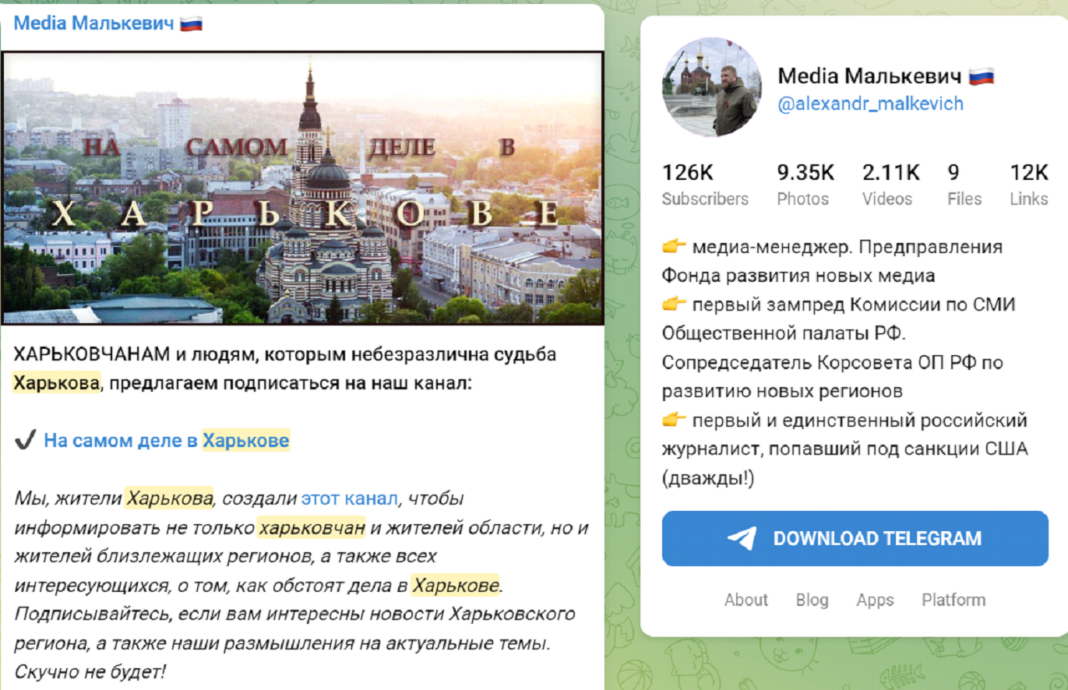Russian propagandists have created an entire infrastructure for the promotion of propaganda related to events in the Kharkiv region. We are talking about websites, telegram channels, radio and printed products. Such media often have the word “Kharkiv” in their name, but have nothing to do with the city itself.
The main goal is to create an illusion that Kharkiv is a part of Russia. The main goal targets different audiences. Propaganda works both on the supporters of Vladimir Putin in Russia, who are shown the successes and the “offensive on Kharkiv”, and on the audience in Ukraine, whom they are trying to show that Russia’s victory is inevitable.
In May 2024, a year and a half after the deoccupation of a large part of the Kharkiv region, the Russians began to advance in the north of the million-strong city again. Preparations for this offensive began precisely with information attacks that reinforced the shelling of civilian objects.
Preparation for the offensive
Serhii Zhukov, an analyst at the Center for Strategic Communications and Information Security under the Ministry of Culture and Information Policy of Ukraine, notes that Russians started preparing for the offensive towards Kharkiv as early as the end of March, when Russians first hit the city with a guided aerial bomb.
Since April, the spokesman of the President of Russia, Dmitriy Peskov, has stated about the need to create a sanitary zone on the territory of the Kharkiv region several times.
On April 22, Russians attacked the television tower in Kharkiv, as a result, it was destroyed. After that, Kharkiv residents reported the disappearance of the TV signal in the city. But the key goal in the destruction of the TV tower was to create problems in obtaining information in the territories bordering Russia.
Analysts of the Center for Strategic Communications and Information Security recorded a large number of targeted Facebook advertisements with fakes about “blocking exits from Kharkiv”, “surrender” of the city, its “doom”, “mass flight of Kharkiv residents”, “secret evacuation of authorities”.
For example, in April, the State Emergency Service (SES) reported a false mailing on behalf of the service.
For example, a memo was distributed on Telegram channels, supposedly on behalf of the Service, on which routes to evacuate the city if it is threatened by Russian encirclement. But it turned out to be a fake.
In May, the Russians carried out several attacks on civilian enterprises, in particular, on the “Epicentr” shopping center, where hundreds of civilians were at that moment. According to Serhii Zhukov, the purpose of such strikes was to create panic among Kharkiv residents.
“At the same time, Telegram channels began to distribute old videos from February 2022 with the mass exodus of people from Kharkiv. Such videos were issued as fresh. This is one of the examples of creating panic,” Serhiy Zhukov noted.
On the eve of the offensive in the Kharkiv region, Russians worked to demoralize local residents. To do this, they were intimidated with the help of disinformation, provoked panic and the flight of the population to other regions, promoted the thesis “peace at any price” in order to increase pressure on the Ukrainian authorities.
The beginning of the offensive
The Kharkiv media “Gvara Media” has a separate fact-checking department.
Journalist Yulianna Topolok says that the activity of the propagandists was inconstant. At the end of 2023, propagandists almost didn’t create fakes about Kharkiv. However, since mid-January the situation has changed.
“Then we saw the first wave of inquiries about whether there would be an attack on Kharkiv. It was published in the British edition of The Telegraph,” she said.
On May 10, Russian troops began active operations north of Kharkiv.
According to Yevhen Lisichkin, a fact-checker of the “Kharkiv Anti-Corruption Center” NGO, after May 10, Russian propagandists focused specifically on the events in Kharkiv.
“In the first days of the second offensive, the events on the front around the settlements of Vovchansk and Liptsi were presented by the Russians in such a way that it was alleged that the resistance of the Ukrainian troops would soon be overcome and then the way to Kharkiv would be open,” Lisichkin notes.
After the Ukrainian troops stabilized the front and pushed the Russians towards the border, the channels of propagandists began to spread articles about the heavy losses of Ukrainians.
Russian Telegram channels actively spread fakes aimed at discrediting the authorities of the city and region. For this, forged documents were created.

Lisichkin notes that the main topic for creating fakes in Kharkiv Oblast is now mobilization. For example, Russian Telegram channels spread several fakes about the mobilization of teenagers in Ukraine.
“After the start of the offensive, messages about Kharkiv began to appear much more often in all-Russian telegram channels, in informational messages from the channels of “military correspondents” with millions of subscribers, – noted Lisichkin.
Yulianna Topolok also mentioned discreditation of the authorities.
“Furthermore, we had a new wave of discrediting mobilization measures and military personnel. According to our observations, Russian propaganda’s interest in the Kharkiv region has dropped significantly since June, the journalist said.
On May 10, the offensive of the troops of the aggressor country was accompanied by the active work of Russian propagandists. Telegram channels worked actively. For instance, a pool of channels coordinated by Oleksandr Malkevich.
Lesya Bidochko, deputy head of the “Media Detector” research center, notes that Russian propaganda worked for several audiences: Ukrainian, domestic (Russian), and foreign.
Its main task was to convince its audience that Russia had already won the war and would “win” even more every day.
Bidochko notes that pro-Russian telegram channels aimed at Ukrainian audiences promoted the idea that Ukrainian politicians who did not take care of proper defense were to blame for the Russian offensive in Kharkiv Oblast. In particular, it was about monitoring how money is spent on the construction of defense fortifications in the Kharkiv region. The Ukrainian side explains the lack of fortifications along the part of the border in the Kharkiv region by the fact that they could not be built due to Russian shelling.
To the external audience, propagandists interpreted the situation in Kharkiv Oblast as follows: Russia has irrevocably gained an advantage on the battlefield, will occupy more and more territories, and the future will only get worse for Ukraine.
But the Russians did not manage to advance quickly to Kharkiv itself. And at the end of May, the number of mentions of the attack on Kharkiv decreased in the z-segment of popular Russian Telegram channels.
“The propagandists began to admit that it is becoming more and more difficult to advance every day. The Armed Forces managed to transfer reserves to this part of the front, supply it with FPV drones and artillery. Some z-bloggers even asked not to talk more about the lack of fortifications of the Armed Forces in the Kharkiv direction, because then the low pace of advancement here recently is incomprehensible. Partially, the z-channels explained the slow-down of the offensive to the limited resources that Russia used here. Like, the offensive operation had limited goals,” Lesya Bidochko noted.
Oleksandr Malkevich is one of those who coordinates the directions of Russian propaganda, especially in the occupied territories of Ukraine.
Media of Malkevich
Russian Oleksandr Malkevich was the general director of the TV channel “St. Petersburg”, a member of the Public Chamber of the Russian Federation. Since 2019, his company “Fund for the Protection of National Values” (FZNC) has contributed to the “global influence” operations of the founder of the private military company “Wagner” Yevhenii Prigozhin. For this, Malkevich ended up on the US sanctions list in 2021.
After the start of the full-scale invasion, Malkevich became a media coordinator in the occupied territories of Ukraine: in the Kherson, Zaporizhzhia, and Donetsk regions.
His media holding has been operating in the temporarily occupied territories of Ukraine since August 2022. But Malkevich’s work was not limited to the occupied territories. He coordinated a whole network of telegram channels, which were created for various cities of Ukraine, including Kharkiv.
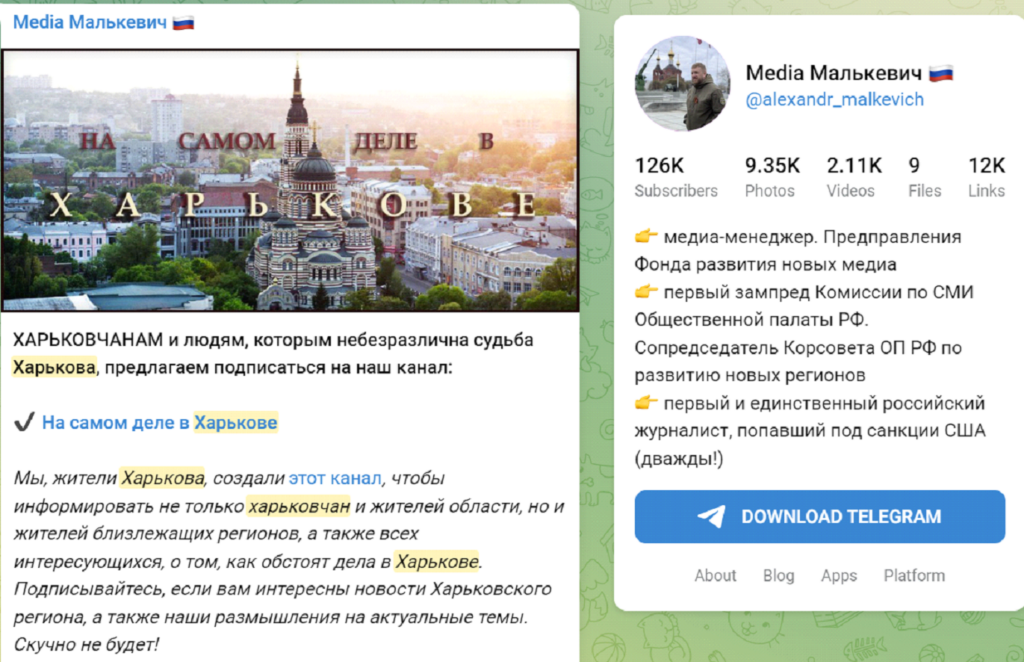
“Malkevich himself denies his role as the official curator of new media in the occupied territories and calls his activity “media volunteering”, claiming that he is simply “helping local residents”. This statement is weakly compatible with the fact that the “locals” were already creating their own media when Malkevich came and replaced them with his own projects,” says Lesya Bidochko
According to her, Malkevich devoted a lot of time and resources to recruiting and training young people in the occupied territories. He even got the position of head of the journalism department at Kherson University (Malkevich claims that “half of the Tavriya TV channel” studies there). He also published a textbook on “Russian journalistic work” in the occupied territories. And he founded the Fund for the Development of New Media with unknown donors, which he actively uses to organize media trainings and competitions for young journalists, internships in Russian mass media, trips to Russian cities, etc.
For example, a journalist from Pskov, Oleksandra Pavlova, came to Belgorod in 2023 and became the editor-in-chief of the propaganda radio “Z FM”, as well as the Telegram channel “First Kharkiv”. In one of her broadcasts, Pavlova mentioned that she received funding from the Malkevich Foundation, whom she called her “teacher and mentor.”
Telegram channels
On the TgStat website, you can find dozens of Telegram channels that position themselves as they are from Kharkiv, but have Russian content, and are run by administrators from Russia.
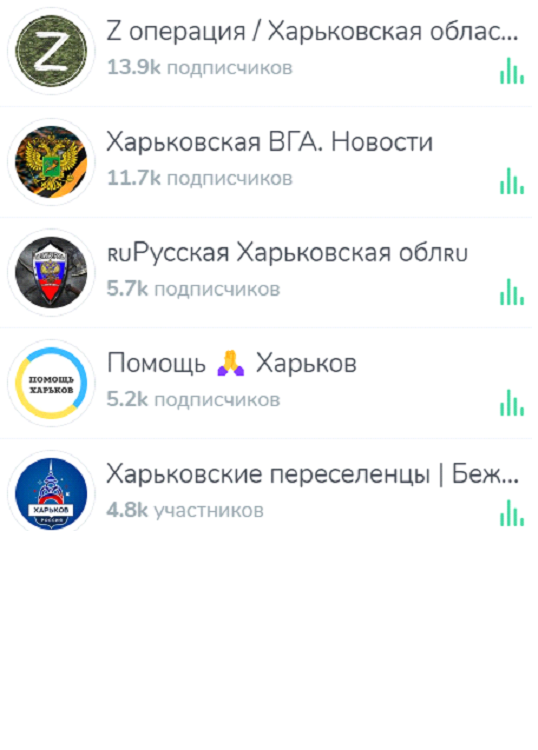
Examples of pro-Russian Telegram channels
Here is an example of the “Kharkov Z Veschaet” Telegram channel, which has more than 7,000 subscribers.

The channel presents itself as a news channel with unique information about Kharkiv. But at the same time, the channel administrator is Vlad, who has an account named ffastadvs. A person with this nickname is the administrator of more than 20 Telegram channels focused on Russia. One of them is a Wagner channel.
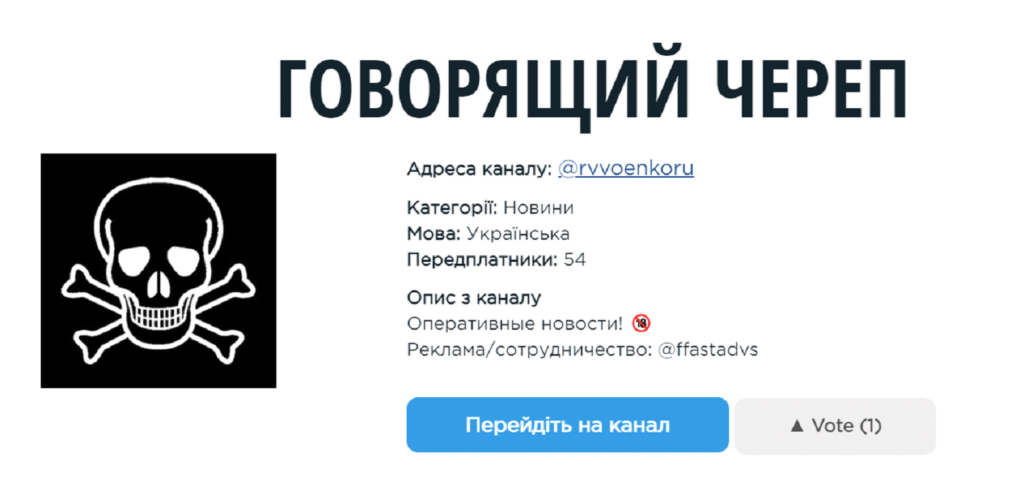
In addition, there are telegram channels that are controlled by the so-called “Military-Civil Administration of the Kharkiv Region” and its head Vitaly Hanchev.
Hanchev is a former police officer who supported the separatists in 2014. In 2022, he headed the civil administration in the Russian-occupied territory of the Kharkiv region. Since September 2022, after Ukrainian troops de-occupied most of the territory of Kharkiv Oblast, Hanchev has been working in Russia.
One of the main tasks of Hanchev and his team is propaganda and creating the illusion that Kharkiv is allegedly part of Russia.
For propaganda, the administration uses various sources, telegram channels ((Pervyi Kharkovskiy, Hanchev Hovorit), works with immigrants from the Kharkiv region, in particular, with young people, as well as distributes newspapers in the occupied territories.
Printed edition
In 2022, Russians distributed the propaganda newspaper “Kharkov Z” in the occupied territories of the Kharkiv region.
After the de-occupation of almost the entire region in the fall of 2022, the publication of this newspaper ceased. However, after the beginning of the Russian offensive on Vovchansk, north of Kharkiv, the Russians resumed distribution of this newspaper, TASS reported.
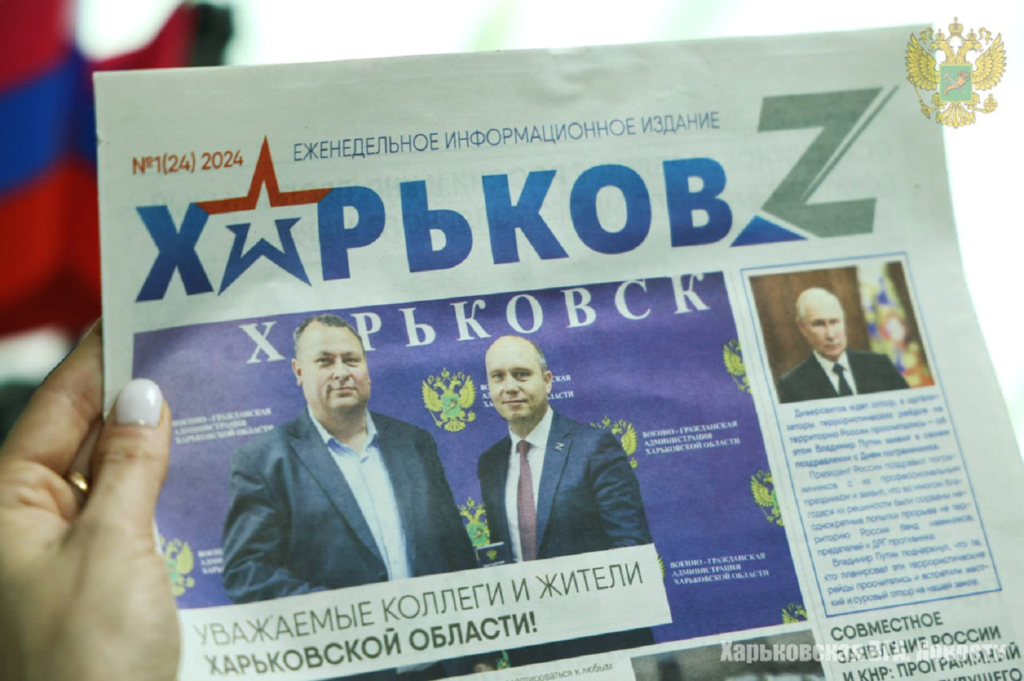
“This makes sense, because they opened an additional front. The propaganda newspaper “Kharkov Z” is published again. This indicates that along with the repeated offensive on Vovchansk, Liptsi, an additional budget was allocated for activity in the information field,” Yevhen Lisichkin notes.
In general, in June-July, the number of Russian propaganda and fakes sent to Kharkiv residents decreased compared to April-May.
But on July 15, Andriy Kovalenko, head of the Center for Countering Disinformation, reported that the Russians had sent additional reserves of troops in Vovchansk. And this means that the intensification of the fighting will also lead to the strengthening of the work of propagandists, who will use all available resources to promote disinformation that Russians will allegedly capture Kharkiv.
Author: Pavlo Novyk specially for Mediaguard.co
